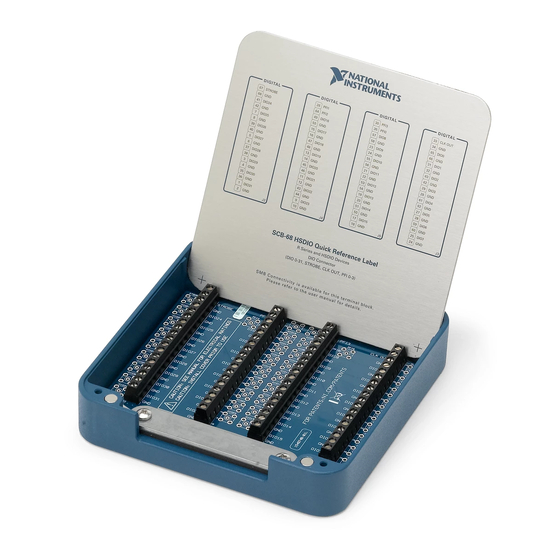
Table of Contents
Advertisement
Quick Links
CONNECTION GUIDE AND SPECIFICATIONS
NI SCB-68 HSDIO
68-Pin Shielded Connector Block
The NI SCB-68 HSDIO is a shielded I/O connector block with 72 screw terminals for
connecting signals to a 68-pin very-high-density cable interconnect (VHDCI) connector.
Setting up the NI SCB-68 HSDIO
Before you begin, review the following safety information about hazardous voltages and
connector blocks.
Cautions
your device documentation for information about the electrical limits of your device.
Install the cover before use. To avoid electrical shock, do not remove NI SCB-68
HSDIO covers unless you are qualified to do so. Before removing the cover,
disconnect any live circuit from the connector block. Replace the cover for use.
The chassis ground lug on the NI SCB-68 HSDIO is for grounding high-impedance
sources, such as a floating source (1 mA maximum). Do not use the chassis ground
lug as a safety earth ground.
Do not connect hazardous voltages (>30 V
/42 V
/60 VDC). Refer to
rms
pk
Advertisement
Table of Contents

Summary of Contents for National Instruments NI SCB-68 HSDIO
- Page 1 CONNECTION GUIDE AND SPECIFICATIONS NI SCB-68 HSDIO 68-Pin Shielded Connector Block The NI SCB-68 HSDIO is a shielded I/O connector block with 72 screw terminals for connecting signals to a 68-pin very-high-density cable interconnect (VHDCI) connector. Setting up the NI SCB-68 HSDIO Before you begin, review the following safety information about hazardous voltages and connector blocks.
- Page 2 Figure 1 shows the parts of the NI SCB-68 HSDIO. Figure 1. NI SCB-68 HSDIO Parts Locator Diagram Top cover (required) Enclosure base Strain-relief bar Quick reference label Strain-relief screws NI SCB-68 HSDIO board assembly 2 | ni.com | NI SCB-68 HSDIO Connection Guide & Specifications...
- Page 3 Screw terminals Ground lugs 68-pin I/O connector To get started with the NI SCB-68 HSDIO, complete the following steps while referring to Figures 1 and 2. You can stand up the cover of the NI SCB-68 HSDIO for easy reference, as Note shown in Figure 1.
- Page 4 The NI 9913 DIN rail mounting kit (part number 783198-01) contains one clip for mounting the NI SCB-68 HSDIO on a standard 35 mm DIN rail. Fasten the DIN rail clip to the enclosure using the two flathead #6-32 × 1/4” screws included in the kit with a #2 Phillips screwdriver, as shown in Figure 3.
-
Page 5: Securing The Cover
In most cases, attaching the cover with the integrated magnets is sufficient to secure it. Complete the following steps if you want to permanently secure the cover to the NI SCB-68 HSDIO base. Using a 3.5 mm (9/64 in.) diameter drill bit, drill two holes through the silkscreened crosshairs on the label side of the cover. - Page 6 2009-1511-0050 Special Considerations for HSDIO Connections National Instruments recommends using 50 Ω cables for all signal connections. If you do not use 50 Ω cables, your application may be affected by signal reflections. You can limit the amplitude of signal reflections by terminating output lines with Schottky diodes, as shown in Figure 5.
-
Page 7: Specifications
Relative humidity Operating ..........5 to 90% RH, noncondensing Storage ............5 to 90% RH, noncondensing Pollution Degree ..........2 Maximum altitude..........2,000 m Indoor use only. NI SCB-68 HSDIO Connection Guide & Specifications | © National Instruments | 7... -
Page 8: Electromagnetic Compatibility
To obtain product certifications and the DoC for this product, visit ni.com/ , search by model number or product line, and click the appropriate link in the certification Certification column. 8 | ni.com | NI SCB-68 HSDIO Connection Guide & Specifications... -
Page 9: Environmental Management
NI product. Refer to the Export Compliance Information at ni.com/legal/export-compliance for the National Instruments global trade compliance policy and how to obtain relevant HTS codes, ECCNs, and other import/export data. © 2013 National Instruments. All rights reserved.







